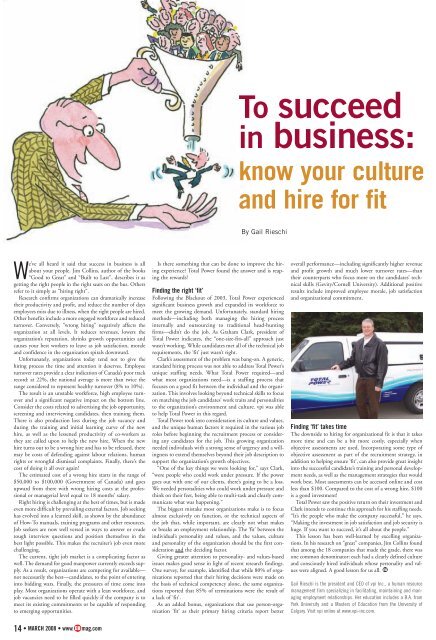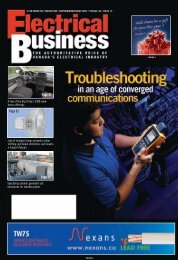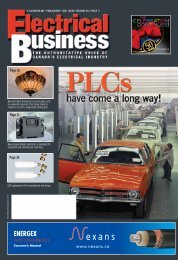Page 11 Page 34 Page 22 - Electrical Business Magazine
Page 11 Page 34 Page 22 - Electrical Business Magazine
Page 11 Page 34 Page 22 - Electrical Business Magazine
- No tags were found...
Create successful ePaper yourself
Turn your PDF publications into a flip-book with our unique Google optimized e-Paper software.
To succeedin business:know your cultureand hire for fitBy Gail RieschiWe’ve all heard it said that success in business is allabout your people. Jim Collins, author of the books“Good to Great” and “Built to Last”, describes it asgetting the right people in the right seats on the bus. Othersrefer to it simply as “hiring right”.Research confirms organizations can dramatically increasetheir productivity and profit, and reduce the number of daysemployees miss due to illness, when the right people are hired.Other benefits include a more engaged workforce and reducedturnover. Conversely, “wrong hiring” negatively affects theorganization at all levels. It reduces revenues, lowers theorganization’s reputation, shrinks growth opportunities andcauses your best workers to leave as job satisfaction, moraleand confidence in the organization spirals downward.Unfortunately, organizations today tend not to give thehiring process the time and attention it deserves. Employeeturnover rates provide a clear indication of Canada’s poor trackrecord: at <strong>22</strong>%, the national average is more than twice therange considered to represent healthy turnover (8% to 10%).The result is an unstable workforce, high employee turnoverand a significant negative impact on the bottom line.Consider the costs related to advertising the job opportunity,screening and interviewing candidates, then training them.There is also production loss during the job vacancy andduring the training and initial learning curve of the newhire, as well as the lessened productivity of co-workers asthey are called upon to help the new hire. When the newhire turns out to be a wrong hire and has to be released, theremay be costs of defending against labour relations, humanrights or wrongful dismissal complaints. Finally, there’s thecost of doing it all over again!The estimated cost of a wrong hire starts in the range of$50,000 to $100,000 (Government of Canada) and goesupward from there with wrong hiring costs at the professionalor managerial level equal to 18 months’ salary.Right hiring is challenging at the best of times, but is madeeven more difficult by prevailing external factors. Job seekinghas evolved into a learned skill, as shown by the abundanceof How-To manuals, training programs and other resources.Job seekers are now well versed in ways to answer or evadetough interview questions and position themselves in thebest light possible. This makes the recruiter’s job even morechallenging.The current, tight job market is a complicating factor aswell. The demand for good manpower currently exceeds supply.As a result, organizations are competing for available—not necessarily the best—candidates, to the point of enteringinto bidding wars. Finally, the pressures of time come intoplay. Most organizations operate with a lean workforce, andjob vacancies need to be filled quickly if the company is tomeet its existing commitments or be capable of respondingto emerging opportunities.Is there something that can be done to improve the hiringexperience? Total Power found the answer and is reapingthe rewards!Finding the right ‘fit’Following the Blackout of 2003, Total Power experiencedsignificant business growth and expanded its workforce tomeet the growing demand. Unfortunately, standard hiringmethods—including both managing the hiring processinternally and outsourcing to traditional head-huntingfirms—didn’t do the job. As Graham Clark, president ofTotal Power indicates, the “one-size-fits-all” approach justwasn’t working. While candidates met all of the technical jobrequirements, the ‘fit’ just wasn’t right.Clark’s assessment of the problem was bang-on. A generic,standard hiring process was not able to address Total Power’sunique staffing needs. What Total Power required—andwhat most organizations need—is a staffing process thatfocuses on a good fit between the individual and the organization.This involves looking beyond technical skills to focuson matching the job candidates’ work traits and personalitiesto the organization’s environment and culture. vpi was ableto help Total Power in this regard.Total Power took into consideration its culture and values,and the unique human factors it required in the various jobroles before beginning the recruitment process or consideringany candidates for the job. This growing organizationneeded individuals with a strong sense of urgency and a willingnessto extend themselves beyond their job description tosupport the organization’s growth objectives.“One of the key things we were looking for,” says Clark,“were people who could work under pressure. If the powergoes out with one of our clients, there’s going to be a loss.We needed personalities who could work under pressure andthink on their feet, being able to multi-task and clearly communicatewhat was happening.”The biggest mistake most organizations make is to focusalmost exclusively on function, or the technical aspects ofthe job that, while important, are clearly not what makesor breaks an employment relationship. The ‘fit’ between theindividual’s personality and values, and the values, cultureand personality of the organization should be the first considerationand the deciding factor.Giving greater attention to personality- and values-basedissues makes good sense in light of recent research findings.One survey, for example, identified that while 80% of organizationsreported that their hiring decisions were made onthe basis of technical competency alone, the same organizationsreported that 85% of terminations were the result ofa lack of ‘fit’.As an added bonus, organizations that use person-organization‘fit’ as their primary hiring criteria report betteroverall performance—including significantly higher revenueand profit growth and much lower turnover rates—thantheir counterparts who focus more on the candidates’ technicalskills (Gevity/Cornell University). Additional positiveresults include improved employee morale, job satisfactionand organizational commitment.Finding ‘fit’ takes timeThe downside to hiring for organizational fit is that it takesmore time and can be a bit more costly, especially whenobjective assessments are used. Incorporating some type ofobjective assessment as part of the recruitment strategy, inaddition to helping ensure ‘fit’, can also provide great insightinto the successful candidate’s training and personal developmentneeds, as well as the management strategies that wouldwork best. Most assessments can be accessed online and costless than $100. Compared to the cost of a wrong hire, $100is a good investment!Total Power saw the positive return on their investment andClark intends to continue this approach for his staffing needs.“It’s the people who make the company successful,” he says.“Making the investment in job satisfaction and job security ishuge. If you want to succeed, it’s all about the people.”This lesson has been well-learned by excelling organizations.In his research on “great” companies, Jim Collins foundthat among the 18 companies that made the grade, there wasone common denominator: each had a clearly defined cultureand consciously hired individuals whose personality and valueswere aligned. A good lesson for us all.Gail Rieschi is the president and CEO of vpi Inc., a human resourcemanagement firm specializing in facilitating, maintaining and managingemployment relationships. Her education includes a B.A. fromYork University and a Masters of Education from the University ofCalgary. Visit vpi online at www.vpi-inc.com.14 • MARCH 2008 • www. mag.com
















